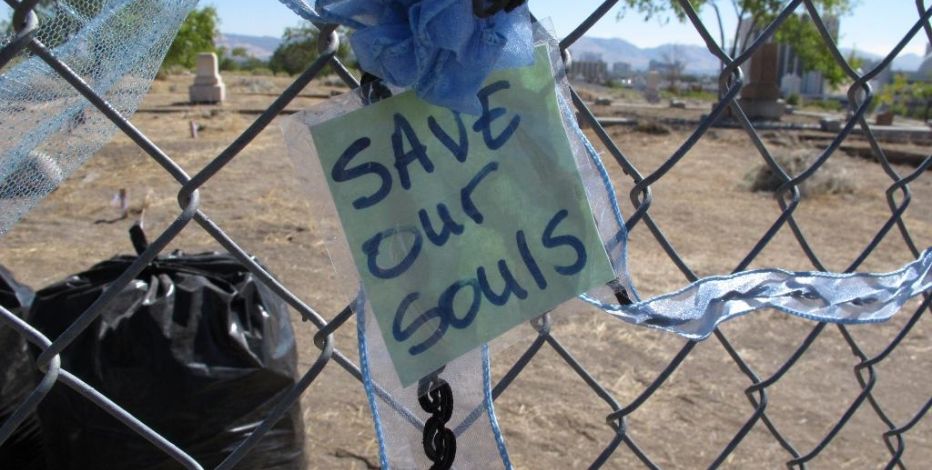
A pioneer cemetery on the edge of downtown Reno where the remains of Civil War soldiers, city founders and a tribal chief have rested for more than a century has been anything but restful in recent weeks.
The cemetery’s owners want to dig up as many as 1,100 graves on one end of the 6-acre site and move them to the other end to make way for a development. Reno residents and heirs of the dead are outraged, calling the cemetery a Nevada historical treasure that should not be disturbed.
“Save our souls,” reads a handwritten note between fluttering ribbons tied to the chain-link fence that encircles Hillside Cemetery. Next to the note is a sign bolted to the fence with a markedly different tone: “Notice of determination for disinterment and removal of human remains.”
The owners posted the notice, secured health permits to move remains and alerted family members in recent weeks in accordance with a 2001 state law known as the Cemetery Authority Act.
After encountering a groundswell of opposition, the owners said Sunday they’ve temporarily suspended any plans for exhumations. But critics remain concerned.
“They call it the Cemetery Authority Act. I call it the Grave Robbers Law,” said Fran Tryon, a retired teacher and genealogist who founded the Hillside Cemetery Preservation Foundation.
The site overlooking Interstate 80 a half-mile (0.8 kilometers) from the main casino drag is Reno’s oldest cemetery, the final resting place for hundreds who reflect northern Nevada’s unique frontier past. Granite tombstones and wooden markers sit atop many of the graves, while others are marked by tiny flags or simply a pile of rocks.
The buried include a former Kentucky congressman who moved to Nevada in 1870 and later was appointed a national bank examiner by President Grover Cleveland. Not far away are the remains of Paiute Chief Johnson Sides, who worked as an interpreter and “peacemaker” for the U.S. Army.

Also interred at Hillside are state lawmakers, saloon keepers, train-hopping hobos and dozens of infant victims of scarlet fever and other epidemics from the early 1900s.
“This is northern Nevada’s history,” Tryon told The Associated Press during a recent tour of the property. “These are our founding fathers.”
Facing the prospect of hundreds of graves being moved, volunteers have spent months removing weeds and litter, and posting makeshift signs and markers on the blighted grounds that had become overgrown with sagebrush.
Health officials say opponents’ fears that exhuming the graves could spread anthrax and other diseases are largely unfounded. The only real threat would be to workers doing the digging, who will wear protective clothing.
“Each set of remains would be relocated in its own container,” the Reno health district said in a release.

Drew Lawton, owner of another cemetery that controls Hillside, last week assured the Reno City Council exhumation of graves was not imminent. And on Sunday, just before meeting with dozens of heirs of the dead, he issued a statement on behalf of the cemetery that said in view of “a few families’ unfavorable responses,” any potential disinterment is on hold. He declined to elaborate.
Lawton said in a previous statement that any renovation would include appropriate monuments, fencing and financial provisions for the cemetery’s ongoing care, and any work would be done by archaeologists and other experts.
Developer Vinton Hawkins has the option to buy the land. His spokesman, Reno lobbyist Greg Ferraro, said earlier they envisioned a “multi-phased project” and that discussion about long-term development was premature.
“The Cemetery Authority has gone above and beyond what Nevada law requires in an effort to connect with families,” Ferraro said in a statement.
Tryon acknowledged past problems with vandalism and dumping at the site. But she said neighboring fraternities and sororities that once partied there have helped with cleanup in recent years. Over Labor Day weekend, they helped fill more than a dozen garbage bags with weeds and trash.
Jeremy Lambert, a U.S. military veteran who lives across the street, joined the cleanup effort four months ago.
“I didn’t like all the weeds,” Lambert said. “Then I saw the foundation’s site on Facebook and started to learn about all the veterans here — Civil War, Spanish American War, World War I.

